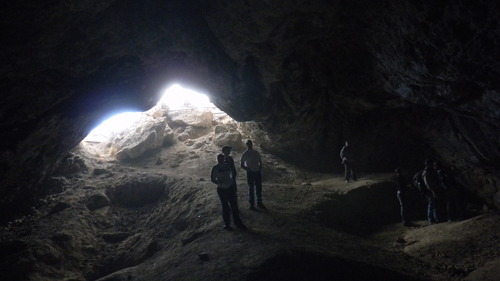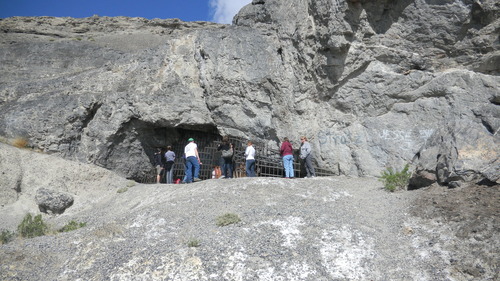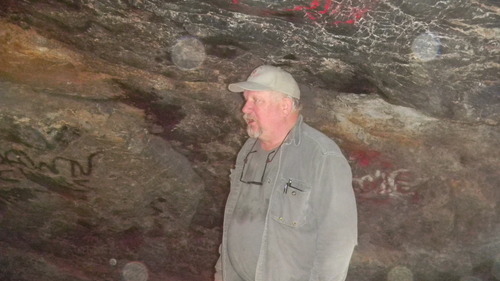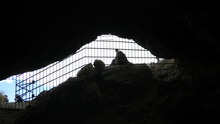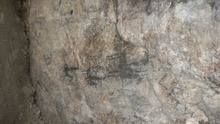This is an archived article that was published on sltrib.com in 2011, and information in the article may be outdated. It is provided only for personal research purposes and may not be reprinted.
Wendover • Mysteries abound in Utah's west desert.
Take, for example, a 400-acre piece of land near Wendover's bustling casinos, next to the famous Bonneville Salt Flats Speedway and within sight of Interstate 80.
It's a state park not often found on Utah road maps or in tourist literature. Signs of the oldest humans to inhabit Utah dating back 11,300 years ago were found here. It was the site of one of the most famous archaeological studies in the U.S. And World War II soldiers stationed in Wendover to work on the Manhattan Project often held dances here.
If you haven't heard of Danger Cave State Park, chances are you are not alone.
Although Danger and Juke Box caves have been part of the park system since the 1960s, they have never been developed. Bars were put over the cave entrances in 1998 to protect the archaeological resources inside from vandalism. There are no signs directing tourists to the caves.
But the caves are occasionally open to the public, sometimes for classes and digs, and sometimes for education. Archaeologists will give tours to the public on May 14 as part of Utah Archaeology Week. Former state Archaeologist David Madsen, who has excavated in Danger Cave, is leading the tours. Tours to the caves for Archaeology Week filled up quickly.
Current state Archaeologist Kevin Jones recently led an excursion into the two caves for University of Utah students studying archaeological law.
"Danger Cave is one of the best-known archaeological sites in the country," said Jones. "Its human history dates back over 11,000 years. There is still a little work done every year there because we can do things now we couldn't in the past."
The cave was originally called Hands and Knees Cave when first visited by archaeologists, including Robert Heizer in the 1930s, because that's how they had to enter it. The name was changed when a large rock fell off the cliff face and narrowly missed an archaeological crew.
Juke Box Cave, located a few hundred yards north of Danger Cave, also was referred to as "Indian Cave" or "Picture Cave" because of the rock art found inside. It got its current name in 1943 when soldiers from Wendover Air Base working on the Manhattan Project leveled a back portion of the cave and hauled up materials to create a dance floor. Considering the hot summer desert climate, it must have been a great place to beat the heat.
Heather Leeflang, of Salt Lake City, who took Jones' recent tour, said her late grandmother, Arlean Simmons, told her stories of spending time inside Juke Box Cave as a teenager. She drove from Salt Lake to dance with some of the soldiers.
"As an adult, she took a continuing education class and came out here," recalled Leeflang. "She talked to us about it. I didn't realize she had been there until we drove out. It feels like a special privilege to be in a place where she was."
Indeed, any visit to these caves feels like a privilege.
The caves are two of about 25 such "solution caves" in the area that were formed by Lake Bonneville. Jones said Danger Cave is particularly important to archaeologists due to the work of University of Utah Field Schools under the direction of Jesse Jennings from 1949 to 1953.
That was because Jennings was one of the first to use radon carbon dating and publish his findings that showed just how well it worked. Jones has found the first hearth inside the cave where Jennings works. On the tour, he lights the cave to show a deep trench where work using more modern techniques still occurs.
The dry nature of the cave preserves artifacts such as cordage from plant fibers, leather, basketry and wooden artifacts in relatively good condition. The deep trench is stratified, with different artifacts found in different layers representing the entire sequence of human occupation in the Great Basin.
"The early people were mostly hunters and gatherers," said Jones. "The area looked different. There were springs, marshes and bogs, but the demand for water for mining and Wendover changed things."
wharton@sltrib.com twitter: @tribtomwharton —
Utah Archaeology Week
For a complete listing of Utah Archeology Week events, log on to http://1.usa.gov/iyY7VP.
Salt Lake City Area
May 7 • Archaeology Week open house at Rio Grande Depot, 10 a.m. to 3 p.m. Learn about archaeology at this free event for kids and adults that includes displays, workshops, crafts, demonstrations, atlatl and arts, and Navajo tacos for sale.
May 11 • Ask an Archaeologist, Rio Grande Depot, 11 a.m. to 1 p.m. Do you have any artifacts? Bring them to archaeologists with the Antiquities Section to have them identified.
May 12 • Bones, Bones and More Bones: Learning About Animal Bones, Rio Grande Depot. Learn how archaeologists study animal bones and even bring a bone from home you would like identified. Spots must be reserved by emailing rrood@utah.gov, with the word "bones" in the subject line.
Davis County
May 7 • What did the American Indian Inhabitants of Antelope Island Eat? Junior Ranger program for kids 6 to 12 at Fielding Garr Ranch, though all are welcome.
May 14 • Archaeology and Early Human History in Utah talk by archaeologist Joel Janetski, 2 p.m., Fielding Garr Ranch on Antelope Island.
Grand County
May 12 • Lecture by authors Bill and Beth Sagtetter on their recent book, The Cliff Dwellings Speak, 7 p.m., Moab Information Center.
Carbon County
May 7 • San Rafael Rock Art Tour, 8 a.m. to 5 p.m., meet and leave from USU/College of Eastern Utah Prehistoric Museum north parking lot in Price.
May 12 • Lecture by Don Burge, founding director of the CEU Prehistoric Museum, on the history of the beginning of the museum and his tenure as director, 7 p.m., CEU Prehistoric Museum classroom, Price.
May 14 • Family Activity Day to celebrate the 50th anniversary of the USU/CEU Prehistoric Museum and Utah Archaeology Week, including children's activities such as corn grinding and dinosaur bone preparation, free, 10 a.m. to 2 p.m.
San Juan County
May 7 • 6th annual Four Corners Indian Art Market, 9:30 a.m. to 6 p.m., Edge of the Cedars State Park Museum. Free.
Utah County
May 14 • The Museum of Peoples and Cultures Block Party, 11 a.m. to 3 p.m., Allen Hall in southwest corner of BYU campus. Free.



